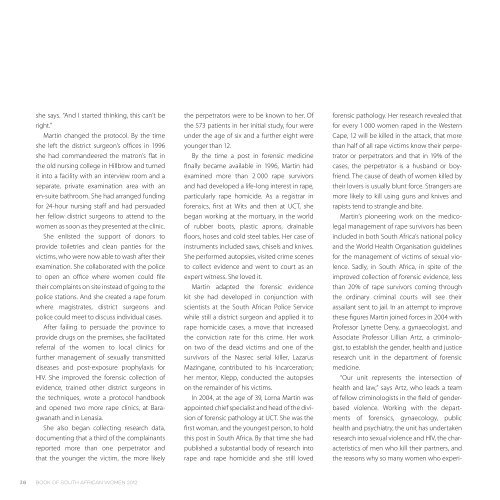Book of South African - Book of Women - Mail & Guardian
Book of South African - Book of Women - Mail & Guardian
Book of South African - Book of Women - Mail & Guardian
Create successful ePaper yourself
Turn your PDF publications into a flip-book with our unique Google optimized e-Paper software.
she says. “And I started thinking, this can’t be<br />
right.”<br />
Martin changed the protocol. By the time<br />
she left the district surgeon’s <strong>of</strong>fices in 1996<br />
she had commandeered the matron’s flat in<br />
the old nursing college in Hillbrow and turned<br />
it into a facility with an interview room and a<br />
separate, private examination area with an<br />
en-suite bathroom. She had arranged funding<br />
for 24-hour nursing staff and had persuaded<br />
her fellow district surgeons to attend to the<br />
women as soon as they presented at the clinic.<br />
She enlisted the support <strong>of</strong> donors to<br />
provide toiletries and clean panties for the<br />
victims, who were now able to wash after their<br />
examination. She collaborated with the police<br />
to open an <strong>of</strong>fice where women could file<br />
their complaints on site instead <strong>of</strong> going to the<br />
police stations. And she created a rape forum<br />
where magistrates, district surgeons and<br />
police could meet to discuss individual cases.<br />
After failing to persuade the province to<br />
provide drugs on the premises, she facilitated<br />
referral <strong>of</strong> the women to local clinics for<br />
further management <strong>of</strong> sexually transmitted<br />
diseases and post-exposure prophylaxis for<br />
HIV. She improved the forensic collection <strong>of</strong><br />
evidence, trained other district surgeons in<br />
the techniques, wrote a protocol handbook<br />
and opened two more rape clinics, at Bara-<br />
gwanath and in Lenasia.<br />
She also began collecting research data,<br />
documenting that a third <strong>of</strong> the complainants<br />
reported more than one perpetrator and<br />
that the younger the victim, the more likely<br />
38 <strong>Book</strong> <strong>of</strong> <strong>South</strong> AfrICAn women 2012<br />
the perpetrators were to be known to her. Of<br />
the 573 patients in her initial study, four were<br />
under the age <strong>of</strong> six and a further eight were<br />
younger than 12.<br />
By the time a post in forensic medicine<br />
finally became available in 1996, Martin had<br />
examined more than 2 000 rape survivors<br />
and had developed a life-long interest in rape,<br />
particularly rape homicide. As a registrar in<br />
forensics, first at Wits and then at UCT, she<br />
began working at the mortuary, in the world<br />
<strong>of</strong> rubber boots, plastic aprons, drainable<br />
floors, hoses and cold steel tables. Her case <strong>of</strong><br />
instruments included saws, chisels and knives.<br />
She performed autopsies, visited crime scenes<br />
to collect evidence and went to court as an<br />
expert witness. She loved it.<br />
Martin adapted the forensic evidence<br />
kit she had developed in conjunction with<br />
scientists at the <strong>South</strong> <strong>African</strong> Police Service<br />
while still a district surgeon and applied it to<br />
rape homicide cases, a move that increased<br />
the conviction rate for this crime. Her work<br />
on two <strong>of</strong> the dead victims and one <strong>of</strong> the<br />
survivors <strong>of</strong> the Nasrec serial killer, Lazarus<br />
Mazingane, contributed to his incarceration;<br />
her mentor, Klepp, conducted the autopsies<br />
on the remainder <strong>of</strong> his victims.<br />
In 2004, at the age <strong>of</strong> 39, Lorna Martin was<br />
appointed chief specialist and head <strong>of</strong> the division<br />
<strong>of</strong> forensic pathology at UCT. She was the<br />
first woman, and the youngest person, to hold<br />
this post in <strong>South</strong> Africa. By that time she had<br />
published a substantial body <strong>of</strong> research into<br />
rape and rape homicide and she still loved<br />
forensic pathology. Her research revealed that<br />
for every 1 000 women raped in the Western<br />
Cape, 12 will be killed in the attack, that more<br />
than half <strong>of</strong> all rape victims know their perpetrator<br />
or perpetrators and that in 19% <strong>of</strong> the<br />
cases, the perpetrator is a husband or boyfriend.<br />
The cause <strong>of</strong> death <strong>of</strong> women killed by<br />
their lovers is usually blunt force. Strangers are<br />
more likely to kill using guns and knives and<br />
rapists tend to strangle and bite.<br />
Martin’s pioneering work on the medicolegal<br />
management <strong>of</strong> rape survivors has been<br />
included in both <strong>South</strong> Africa’s national policy<br />
and the World Health Organisation guidelines<br />
for the management <strong>of</strong> victims <strong>of</strong> sexual violence.<br />
Sadly, in <strong>South</strong> Africa, in spite <strong>of</strong> the<br />
improved collection <strong>of</strong> forensic evidence, less<br />
than 20% <strong>of</strong> rape survivors coming through<br />
the ordinary criminal courts will see their<br />
assailant sent to jail. In an attempt to improve<br />
these figures Martin joined forces in 2004 with<br />
Pr<strong>of</strong>essor Lynette Deny, a gynaecologist, and<br />
Associate Pr<strong>of</strong>essor Lillian Artz, a criminologist,<br />
to establish the gender, health and justice<br />
research unit in the department <strong>of</strong> forensic<br />
medicine.<br />
“Our unit represents the intersection <strong>of</strong><br />
health and law,” says Artz, who leads a team<br />
<strong>of</strong> fellow criminologists in the field <strong>of</strong> genderbased<br />
violence. Working with the departments<br />
<strong>of</strong> forensics, gynaecology, public<br />
health and psychiatry, the unit has undertaken<br />
research into sexual violence and HIV, the characteristics<br />
<strong>of</strong> men who kill their partners, and<br />
the reasons why so many women who experi-


